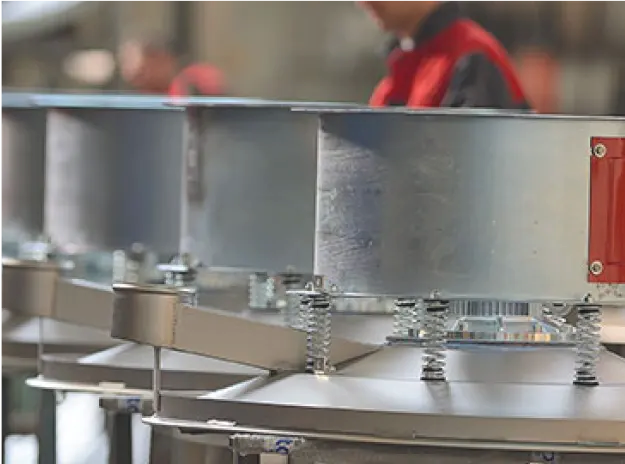We assist in enhancing your, efficiency, and profitability. Our commitment is to collaborate closely with you to tailor our standard offerings, or bespoke needs, ensuring an optimal solution is achieved with your project.
Secure the integrity of your products with our advanced sieves. Rest assured, our products meet the highest regulatory standards, including compliance with the ATEX regulations.
Sieving is an industrial process applied throughout main manufacturing sectors in order to:
- Clean a powder or granular product from undesired particles with bigger dimensions (i.e. lumps, insects, metal parts etc.) or with smaller dimensions (i.e. fine powder) than main valuable product;
- Separate a powder or granular product into groups according to particle dimensions, in order to identify and create different products;
- Dewater a liquid product by separating its solid content from water.
Why is sieving introduced in manufacturing processes?
There can be many reasons, like:
- Safety: sieving is required in order to make sure that undesired particles are not entering together with main product into production cycle. In specific industries like food, this application follows law requirements concerning food production safety. In other industries, like 3D printing, this application is necessary in order to guarantee final component quality.
- Quality: sieving can be an interesting option in order to identify and create different valuable products starting from a bulk ingredient. Particle dimensions can play a role in food, metal powder, construction and many other industries, where each product extracted from bulk can correspond to a different market opportunity.
- Recovery: the circular economy concept is triggering industries to rethink their production process and find ways to make it more sustainable; within this context, sieving can be a good opportunity to extract valuable product from waste and transform it into a new opportunity as a new product to be used or sold.
If we want to explain this more technically, we can refer to below chart, which shows a sample product volume by particle size (i.e. PSD = particle size distribution) and indicates according to required cut point(s) which sieving applications are identified: dedusting (main product is cleaned out from finer particles); safety screening (main product is cleaned out from bigger particles); classification (middle fractions of a product are extracted from bulk according to their particle size).
If you have any requirements, please answer the following questions and email us on sales@wbtservices.co.uk.
If possible please include information regarding:
- Type of product to be sieved (Powder type or liquid / material)
- Bulk density of product (tonnes per meter cubed)
- Required throughput
- Required mesh size
- How is the sieve fed (Screw conveyor / Rotary Valve / Etc (Needs to be control fed normally!)
- What space do you have to fit the unit in
- What finishing do you need (Food grade / Stainless Steel 304 or 316 / Mirror Polishing)
- Do you require the sieve to be ATEX rated (Zone 22 / 21 / 20)
Further Information On Cuccolini Sieves
Safety Sieving (VP2 Type)
- Takes out foreign particles that may be in the product the customer is trying to use
- We use only one sieve deck
- Oversize volume of 3% is still expected
- Sieve cut point is from 0.8mm to 10mm max
- To sieve the product quickly through the application, the product flows in the center only
VP2 Safety Sieves Range (Can be used under the outlet of the Silo)
- 2 motors for high speed
- 1 deck with cut point from 0.8 to 10mm
- Set of mesh cleaning balls
- Side oversize and central undersize outlet
- Sizes 900 – 1200 -1500
- An additional pipe will go down to say 15cm from the mesh when under a silo
Installation Guidelines
- Sufficient room required around the unit (Say 1m), in order that the sieve doesn’t hit anything when in its phases
- Needs a flexible sleeve from the outlet of the first machine to the inlet of the sieve (At least 1.5 times the diameter of the inlet/outlet)
- Maintenance once or twice a year
- Periodically check of sieving mesh conditions
- Soft start on the motor for the control panel to start the sieve up
Classification for Powder & Granules
- Sieve from 1 to 4 decks
- Different oversize volumes %
- To sieve at a cut point between 7um to 10mm
VPB Range
- 1 motor only in the middle of the sieve
- 1 to 4 decks (7um to 10mm mesh)
- Set of mesh cleaning balls (if required)
- Side oversize and undersize outlets
- Wide range of sizes: 450mm to 1500mm
- Cover with inlet, inspection port and venting
- On trolley (450-800mm) or basements (800-1500)
Advantages of Cuccolini Sieves
Cuccolini Sieves are more efficient than the competitors (We can use a 1200mm size compared to the competitors 1800mm for instance). This is done by the years of experience, by obtaining a single sheet of metal formed at the bottom ‘cone’ to get the motor as close as possible – this gives maximum efficiency. The metal is 2.5mm thick and this means less power and faster than the competitors. This is the best solution.
- We do not need lubrication on our motors.
- Mesh is not riveted on like competitors. We use a mechanical installation on putting the mesh on. No glue is used on the food grade equipment. We can re-mesh the ring every time – rather than throwing this away.


